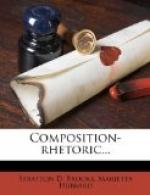—Scott: Lady of the Lake.
7. On nearer approach he was still more surprised at the singularity of the stranger’s appearance. He was a short, square-built old fellow, with thick, bushy hair and a grizzled beard. His dress was of the antique Dutch fashion—a cloth jerkin strapped around the waist—several pairs of breeches, the outer ones of ample volume, decorated with rows of buttons down the sides and bunches at the knees. He bore on his shoulder a stout keg that seemed full of liquor, and made signs for Rip to approach and assist him with his load.
—Washington Irving: Rip Van Winkle.
+27. Complete and Incomplete Images.+—Some sentences have for their purpose the presentation of an image, but in order to form that image correctly and completely, we must be familiar with the words used. If an unfamiliar word is introduced, the mind may omit entirely the image represented, or may substitute some other for it. Notice the image presented by this sentence from Henry James: “Her dress was dark and rich; she had pearls around her neck and an old rococo fan in her hand.” If the meaning of rococo is unknown to you, the image which you form will not be exactly the one that Mr. James had in mind. The pearls and the dress may stand out clearly in your image, but the fan will be lacking or indistinct. The whole may be compared to a photograph of which a part is blurred. If your attention is directed to the fan, you may recall the word rococo, but not the image represented by it. If your attention is not called to the fan, the mind is satisfied with the indistinct image, or substitutes for it an image of some other fan. Such an image is therefore either incomplete or inaccurate.
An oath in court provides that we shall “tell the truth, the whole truth, and nothing but the truth,” but, in forming images, it is not always possible to hold our minds to such exactness. We are prone to picture more or less than the words convey. In fact, in some forms of prose, and often in poetry, the author purposely takes advantage of this habit of the mind and wishes us to enlarge with creations of our own imagination the bare image that his words convey. Such writing, however, aims to give pleasure or to arouse our emotions. It calls out something in the reader even more strongly than it sets forth something in the writer. This suggestiveness in writing will be considered later, but for the present it will be well for you to bear in mind that most language has for its purpose the exact expression of a definite idea. Much of the failure in school work arises from the careless substitution of one image for another, and from the formation of incomplete and inaccurate images.
EXERCISES
A. Make a list of the words in the following selections whose meanings you need to look up in order to make the images exact and complete. Do not attempt to memorize the language of the definition, but to form a correct image.




